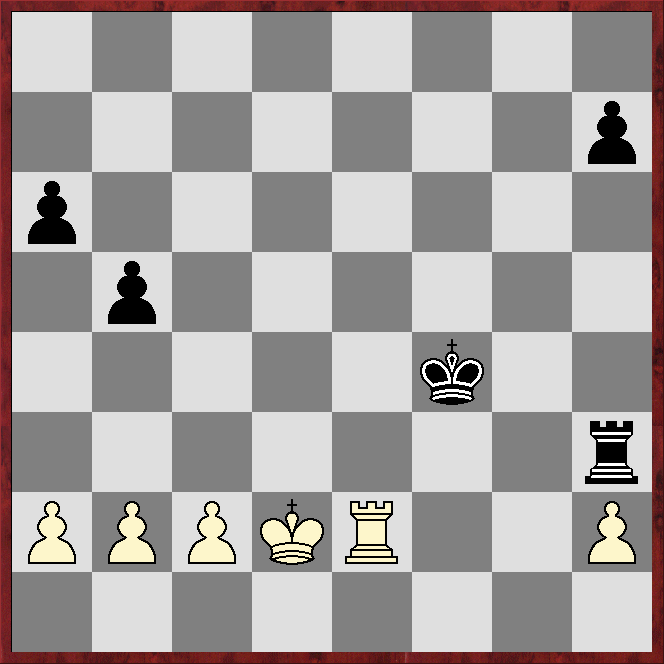Spanton (1954) - Adam Wilczyński (1617)
Sicilian ...e6
1.e4 c5 2.Nf3 e6 3.d4 cxd4 4.Nxd4 Nc6 5.Be3!?
There are 4,644 examples of this move in ChessBase's 2025 Mega database, but much more popular are 5.Nb5!? and especially 5.Nc3. Those moves are also much more successful percentagewise, although Black scores well against all three.
5...Qc7 6.Be2
Black meets 6.Nb5 with 6...Qb8, followed by a quick ...a6.
6...Nf6 7.Nc3 a6 8.0-0
 |
| By a somewhat unusual move-order the game has reached a heavyweight position occurring 12,757 times in Mega25 |
*****
*****
*****
*****
8...Be7 9.Qd2
The main line in Mega25 runs 9.f4 d6 10.Qe1 0-0 11.Qg3 Nxd4 12.Bxd4 b5 13..a3 Bb7, with an equal position, according to Stockfish17 and Dragon1.
9...d6 10.Rad1 0-0
*****
*****
*****
*****
White has more space in the centre and a lead in development; Black has two pawns against one on the central two files. The engines reckon the position is equal.
11.f4 Bd7 12.g4!?
This rare and clearly double-edged move is Dragon1's top choice, at least for a while.
12...Nxd4 13.Bxd4
This was played in all five games to reach the position in Mega25, but the engines prefer 13.Qxd4!? If then, as in the game, 13...e5, the engines continue 14.Qd3 Bxg4 15.Bxg4 Nxg4 16.Nd5 Qd8 17.Bb6 Qe8, when White has obvious compensation for a pawn.
13...e5 14.fxe5
The engines prefer 15.Be3!? or 15.Bf2!?, eg 15.Be3!? Bxg4 16.Bxg4 Nxg4 17.f5, again with decent compensation for White. The engines' 15...Bc6 may be an improvement, eg 16.Bf3 exf4 17.Bxf4 Nd7!? 17.Nd5 Bxd5 18.Qxd5!?, when they give Black the better part of equality.
14...dxe5 15.Bf2 Bc5??
Apparently completely missing the strength of White's reply. Instead 15...Bxg4 16.Bxg4 Nxg4 17.Qd7!? Qxd7 18.Rxd7 Bg5!? is at least slightly better for Black, according to the engines.
16.g5
Black must lose material.
16...Ng4 17.Qxd7 Bxf2+?!
Better, according to the engines, but still losing, is 17...Qxd7 18.Rxd7 Nxf2 19.Rxf2 f6!?
18.Rxf2
The engines give 18.Kh1!? as even stronger.
18...Qxd7 19.Rxd7 Nxf2 20.Kxf2 b5
*****
*****
*****
*****
21.Nd5 Kh8!?
This is Stockfish17's top choice, and comes to be Dragon1's, although in both cases only marginally ahead of several other moves.
22.Bh5 f6 23.gxf6 gxf6 24.Bg4 Rad8 25.Rc7!?
The engines do not like this at first, reckoning it is better to acquiesce to an exchange of rooks, but the text comes to be both engines' top choice, at least for a while.
*****
*****
*****
*****
25...f5!
Forcing a rook-and-pawn ending.
26.Bxf5
There is no sensible alternative.
26...Rxf5+ 27.exf5 Rxd5
 |
| The engines reckon White's advantage is much larger than a 'mere' pawn up would suggest, but rook-and-pawn endings are not only notoriously drawish, they can also be very tricky to play |
*****
*****
*****
*****
28.f6
Threatening mate.
28...Kg8 29.Rg7+ Kh8 30.Ra7!?
Possibly even better is 30.Ke3 or 30.Rg3.
30...Kg8 31.Ke3 Rd6
*****
*****
*****
*****
32.Re7?
Throwing away almost all of White's advantage. Correct is 32.Rg7+, meeting the repetition 32...Kh8 with 33.Rg2 Rxf6 34.Ke4, or 33.Ke4 Rxf6 34.Rg2, and if 34...Re6 then White keeps the black king bottled up for the time being, while creating threats on the queenside. One line given by the engines runs 35.c3 Re8 36.a4 h6 37.a5!? Kh7, and now 38.Rd2 with an advantage worth in the neighbourhood of a rook, according to the engines.
32...Rxf6 33.Rxe5 Rh6 34.Rg5+ Kf7 35.Rg2 Ke6
 |
| White remains a pawn up but both black pieces are more active than their white counterparts, which usually indicates excellent drawing chances in such endings, and this is no exception |
*****
*****
*****
*****
36.Rd2 Ke5 37.Rg2 Rh3+ 38.Kd2 Kf4
The engines prefer moving the king to the d file.
39.Rf2+
Dragon1 reckons White has the upper hand after 39.Re2, cutting the black king off from the queenside. Stockfish17 at first also gives White an edge, but comes to call the position equal, at about the same time as Dragon1's enthusiasm for White's chances declines.
39...Ke4 40.Re2+ Kf4
 |
| Arriving at the position that would have been reached with 39.Re2 - slightly better for White, according to Dragon1, but equal, according to Stockfish17 |
*****
*****
*****
*****
41.c3 a5 42.Kc2 Kf3?
This makes it possible for the white king to escape confinement. Better is a move such as 42...h5.
43.Rd2?
Missing the chance to play 43.Kd3, eg 43...Kf4? 44.Kd4. Better is 43...Rh5, but White can make progress, eg 44.Rd2!? Rd5+ 45.Kc2 Rh5 46.Rd3+ Kg2 47.h3!?, when the try 47...Rxh3?! fails to 48.Rxh3 Kxh3 49.b4! axb4 50.cxb4 h5 51.a4 etc. Another try is 43...Rh4?!, but 44.Re5 Rxh2 45.Rxb5 is winning, according to the engines.
43...Ke4 44.b3
Dragon1 for quite some time insists 44.a4!? wins after 44...bxa4 45.Rd4+ Kf5 46.Rxa4 Rxh2+ 47.Kb3, but Stockfish17 reckons 47...h5 48.Rxa5+ Kg4 is fine for Black, which the Syzygy endgame tablebase confirms.
44...h5 45.c4 b4!?
Dragon1 reckons this is quite a bit better than 45...bxc4, although Stockfish17 comes to see both moves as giving complete equality.
46.Kb2
*****
*****
*****
*****
46...Ke3?
One of the few plausible moves that loses. Perhaps the easiest way to draw is 46...Rf3, eg 47.Rc2 Rf6, but even the awkward-looking 46...Re3!? seems to draw, eg 47.Rc2 Kd4 48.c5 Kd5 49.c6 Re8 50.c7 Rc8, when White appears unable to make progress.
47.Rc2 Kd4
No better is 47...Rf3, when 48.c5 (the engines reckon 48.a3!? and 48.h4!? also win) Rf8 49.c6 h4 50.c7 Rc8 wins, eg 51.Rc4 h3 52.Kc2 Kf3 53.Kd3 Kg2 54.Rc2+ etc. If in this line Black tries 52...Ke2, then 53.Ke4+ Kf3 54.Re7 Kg2 55.Kd3 Kxh2 56.Rg7!? wins.
48.c5 Rc3?!
More challenging is 48...Rf3, albeit transposing into lines similar to the previous note.
49.c6 Kd5 50.c7 1-0





No comments:
Post a Comment